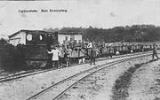
Trench railways
Encyclopedia
Trench Railways represented military
adaptation of early 20th century railway technology to the problem of keeping soldiers supplied during the static trench warfare
phase of World War I
. The large concentrations of soldiers and artillery
at the front lines required delivery of enormous quantities of food
, ammunition
and fortification construction materials where transportation facilities had been destroyed. Reconstruction of conventional roads and railways was too slow, and fixed facilities were attractive targets for enemy artillery. Trench railways linked the front with standard gauge railway facilities beyond the range of enemy artillery. Empty cars often carried litters returning wounded from the front.
had developed portable Decauville
railways for agricultural areas, small scale mining, and temporary construction projects. France had standardized 60-centimenter gauge military Decauville
equipment and Germany
adopted similar feldbahn
of the same gauge. British
War Department Light Railways
and the United States Army Transportation Corps
used the French gauge system. Russia
used Decauville and systems.
Unskilled laborers and soldiers could quickly assemble prefabricated 5 metre sections of track weighing about 100 kilograms (220 lb) along roads or over smooth terrain. The track distributed heavy loads to minimize development of muddy ruts through unpaved surfaces. Small locomotives pulled short trains of 10 tonnes (22,046.2 lb) capacity cars through areas of minimum clearance
and small-radius curves
. Derailments were common, but the light rolling stock was relatively easy to rerail. Steam locomotives typically carried a short length of flexible pipe (called a water-lifter) to refill water tanks from flooded shell holes.
Steam locomotives produced enough smoke to reveal their location to enemy artillery. Steam locomotives required fog or darkness to operate within visual range of the front. Daylight transport usually required animal power until internal combustion locomotives were developed. Large quantities of hay and grain were carried to the front while horse
s remained an essential part of military logistics.

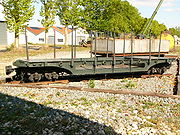 Captain Péchot of the French Artillery designed a 10 tonnes (22,046.2 lb) Fairlie
Captain Péchot of the French Artillery designed a 10 tonnes (22,046.2 lb) Fairlie
articulated 0-4-4-0T locomotive. The French military had 62 Péchot-Bourdon type built between 1888 and 1914. Baldwin Locomotive Works
built 280 more during the war.
Two-hundred-fifty 8 tonnes (17,637 lb) 0-6-0T of Decauville's Progres design were built for military service. Thirty-two 0-6-0T of American design and six-hundred 55 kW gasoline mechanical locomotives were purchased from Baldwin Locomotive Works
.
The Maginot Line
employed a gauge supply system of gasoline-powered armored locomotives and underground electric locomotives pulling cars of World War I
design. Two Péchot-Bourdon locomotives were preserved in the technical museums of Dresden
and Prague
. A portion of the Somme battlefield railway continued in operation and has been preserved as the heritage
Froissy Dompierre Light Railway
.
 Orenstein and Koppel GmbH
Orenstein and Koppel GmbH
manufactured portable track. Krauss designed a 0-6-0T Zwillinge
intended to be operated in pairs with the cabs together. The Zwillinge offered Mallet locomotive
performance through tight curves
, but damage to one unit would not disable the second. One-hundred-eighty-two Zwillinge were manufactured from 1890 through 1903, and shortcomings were evaluated in German South-West Africa
and China's Boxer Rebellion
.
An 11 tonnes (24,250.8 lb) 0-8-0T Brigadelok design with Klein-Linder
articulation of the front and rear axles was adopted as the new military standard in 1901. Approximately 250 were available by 1914, and over two thousand were produced during the war. A Brigadelok typically handled six loaded cars up a 2% grade.
Germany
also had approximately five-hundred 0-4-0T, three-hundred 0-6-0T, and forty 0-10-0T locomotives of other designs in military service.
Deutz AG
produced two-hundred 4-wheel internal combustion locomotives with an evaporative cooling water jacket surrounding the single cylinder oil engine. Fifty similar 6-wheel locomotives were produced by Deutz.
Approximately 20% of the Brigadeloks saw postwar use. Government railways of (Yugoslavia
), Macedonia
, Serbia
and Poland
made extensive use of the military locomotives. Significant numbers were used in Hungary
, France
, Latvia
, Bulgaria
, and Romania
while smaller numbers went overseas to Africa
, Indonesia
, Japan
, and North America
.
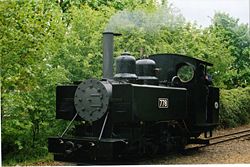
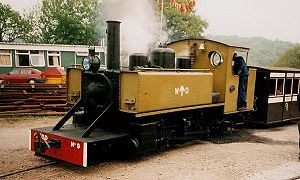
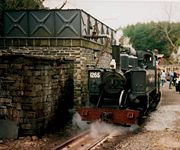 Britain selected a Hunslet Engine Company
Britain selected a Hunslet Engine Company
4-6-0T design as their standard for the French rail gauge; but Hunslet's production of 75 locomotives was insufficient. Baldwin Locomotive Works
produced 495 15 tonnes (33,069.3 lb) 4-6-0T of a less satisfactory American design while Hudswell Clarke
and Andrew Barclay Sons & Co. built 83 0-6-0T locomotives. One-hundred 15 tonnes (33,069.3 lb) 2-6-2T of the American standard military design were later purchased from Alco's Cooke Locomotive Works
for British use.
Britain pioneered use of gasoline powered, 4-wheel synchromesh mechanical drive locomotives called tractors for daylight use within visual range of the front. Early tractors weighed 2 tons. Total production was 102 7 kW Ernest E. Baguley
tractors, 580 15 kW Motor Rail
tractors, and 220 30 kW Motor Rail
tractors. An additional two-hundred 30 kW gasoline-electric tractors were produced by British Westinghouse
and Kerr Stuart
.
Former British trench railway equipment was put to civilian use rebuilding Vis-en-Artois
between Arras
and Cambrai
. Twenty Hudswell-Clarke and Barclay 0-6-0T, seven Alco 2-6-2T, and 26 Baldwin 4-6-0T engines saw service through 1957.
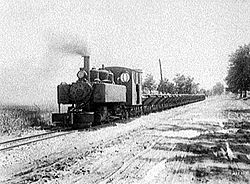 Baldwin Locomotive Works
Baldwin Locomotive Works
produced 15 tonne 2-6-2T numbered 5001-5195. Number 5195 was sent to Davenport Locomotive Works
as a pattern for their production of the design, while another was sent to Magor Car Company to test operation of their military railway car production. Two were lost at sea, and the remaining 191 saw service with the U.S. Army in France. Locomotives were initially painted grey with black smoke boxes. White lettering was applied to early production, but black lettering was used in France. Baldwin also built 5 tonnes (11,023.1 lb) 26 kW and 7 tonnes (15,432.4 lb) 37 kW 4-wheel gasoline mechanical locomotives for the U.S. Army. The lighter locomotives were numbered 8001-8063. The heavier locomotives were numbered 7001-7126 and operated at 2 metres per second or 6.56 ft/s (7.2 km/h (4.5 mph)), roughly the speed of a slow jogger.
The standard American military railway car was 170 centimetre wide and 7 m (23 ft) long riding on two 4-wheel archbar bogie
s. 1,695 of these cars were built by Magor Car Company, American Car and Foundry and Ralston Steel Car Company
. Most were flatcar
s, but some had gondola
sides, others had roofs (either with open sides or like conventional boxcar
s) and others carried shallow rectangular tanks with a capacity of 10000 l (2,641.7 US gal; 2,199.7 imp gal) of drinking water. The boxcar
s and tank car
s were regarded as top-heavy and prone to derailment; so most loads were carried on flatcar
s and gondolas
. Approximately 1600 4-wheel side dump cars were produced in several versions for construction earth-moving.
Davenport Locomotive Works
built one-hundred 15 tonnes (33,069.3 lb) 2-6-2T and Vulcan Iron Works
built thirty more. Whitcomb built 74 7 tonnes (15,432.4 lb) 4-wheel gasoline mechanical locomotives. None of the Davenport, Vulcan, and Whitman production saw overseas service, but some survived through World War II
on United States military bases including Fort Benning, Georgia, Fort Sill, Oklahoma, Fort Benjamin Harrison, Indiana, Fort Dix, New Jersey
, and an arsenal in Alabama
.
. Baldwin Locomotive Works
built 350 seven-tonne 6-wheel gasoline mechanical locomotives for Russia's gauge in 1916.
Military
A military is an organization authorized by its greater society to use lethal force, usually including use of weapons, in defending its country by combating actual or perceived threats. The military may have additional functions of use to its greater society, such as advancing a political agenda e.g...
adaptation of early 20th century railway technology to the problem of keeping soldiers supplied during the static trench warfare
Trench warfare
Trench warfare is a form of occupied fighting lines, consisting largely of trenches, in which troops are largely immune to the enemy's small arms fire and are substantially sheltered from artillery...
phase of World War I
World War I
World War I , which was predominantly called the World War or the Great War from its occurrence until 1939, and the First World War or World War I thereafter, was a major war centred in Europe that began on 28 July 1914 and lasted until 11 November 1918...
. The large concentrations of soldiers and artillery
Artillery
Originally applied to any group of infantry primarily armed with projectile weapons, artillery has over time become limited in meaning to refer only to those engines of war that operate by projection of munitions far beyond the range of effect of personal weapons...
at the front lines required delivery of enormous quantities of food
Food
Food is any substance consumed to provide nutritional support for the body. It is usually of plant or animal origin, and contains essential nutrients, such as carbohydrates, fats, proteins, vitamins, or minerals...
, ammunition
Ammunition
Ammunition is a generic term derived from the French language la munition which embraced all material used for war , but which in time came to refer specifically to gunpowder and artillery. The collective term for all types of ammunition is munitions...
and fortification construction materials where transportation facilities had been destroyed. Reconstruction of conventional roads and railways was too slow, and fixed facilities were attractive targets for enemy artillery. Trench railways linked the front with standard gauge railway facilities beyond the range of enemy artillery. Empty cars often carried litters returning wounded from the front.
Overview
FranceFrance
The French Republic , The French Republic , The French Republic , (commonly known as France , is a unitary semi-presidential republic in Western Europe with several overseas territories and islands located on other continents and in the Indian, Pacific, and Atlantic oceans. Metropolitan France...
had developed portable Decauville
Decauville
The Decauville manufacturing company was founded by Paul Decauville , a French pioneer in industrial railways. Decauville's major innovation was the use of ready-made sections of light, narrow gauge track fastened to steel sleepers; this track was portable and could be disassembled and transported...
railways for agricultural areas, small scale mining, and temporary construction projects. France had standardized 60-centimenter gauge military Decauville
Decauville
The Decauville manufacturing company was founded by Paul Decauville , a French pioneer in industrial railways. Decauville's major innovation was the use of ready-made sections of light, narrow gauge track fastened to steel sleepers; this track was portable and could be disassembled and transported...
equipment and Germany
Germany
Germany , officially the Federal Republic of Germany , is a federal parliamentary republic in Europe. The country consists of 16 states while the capital and largest city is Berlin. Germany covers an area of 357,021 km2 and has a largely temperate seasonal climate...
adopted similar feldbahn
Feldbahn
A Feldbahn is the German term for a narrow gauge railway, usually not open to the public, which in its simplest form provides for the transportation of agricultural, forestry and industrial raw materials such as wood, peat, stone, earth and sand...
of the same gauge. British
United Kingdom
The United Kingdom of Great Britain and Northern IrelandIn the United Kingdom and Dependencies, other languages have been officially recognised as legitimate autochthonous languages under the European Charter for Regional or Minority Languages...
War Department Light Railways
War Department Light Railways
The War Department Light Railways were a system of narrow gauge trench railways run by the British War Department in World War I. Light railways made an important contribution to the Allied war effort in the First World War, and were used for the supply of ammunition and stores, the transport of...
and the United States Army Transportation Corps
United States Army Transportation Corps
The Transportation Corps was established 31 July 1942 by Executive Order 9082. The Transportation Corps is a combat service support branch of the U.S. Army, and was headquartered at Fort Eustis, Virginia, but has now moved to Fort Lee, Virginia. The Transportation Corps is responsible for the...
used the French gauge system. Russia
Russia
Russia or , officially known as both Russia and the Russian Federation , is a country in northern Eurasia. It is a federal semi-presidential republic, comprising 83 federal subjects...
used Decauville and systems.
Unskilled laborers and soldiers could quickly assemble prefabricated 5 metre sections of track weighing about 100 kilograms (220 lb) along roads or over smooth terrain. The track distributed heavy loads to minimize development of muddy ruts through unpaved surfaces. Small locomotives pulled short trains of 10 tonnes (22,046.2 lb) capacity cars through areas of minimum clearance
Structure gauge
The structure gauge, also called the minimum clearance outline, is the minimum height and width of tunnels and bridges as well as the minimum height and width of the doors that allow a rail siding access into a warehouse...
and small-radius curves
Minimum railway curve radius
The minimum railway curve radius, the shortest design radius, has an important bearing on constructions costs and operating costs and, in combination with superelevation in the case of train tracks, determines the maximum safe speed of a curve. Superelevation is not a factor on tramway tracks...
. Derailments were common, but the light rolling stock was relatively easy to rerail. Steam locomotives typically carried a short length of flexible pipe (called a water-lifter) to refill water tanks from flooded shell holes.
Steam locomotives produced enough smoke to reveal their location to enemy artillery. Steam locomotives required fog or darkness to operate within visual range of the front. Daylight transport usually required animal power until internal combustion locomotives were developed. Large quantities of hay and grain were carried to the front while horse
Horse
The horse is one of two extant subspecies of Equus ferus, or the wild horse. It is a single-hooved mammal belonging to the taxonomic family Equidae. The horse has evolved over the past 45 to 55 million years from a small multi-toed creature into the large, single-toed animal of today...
s remained an essential part of military logistics.
French Equipment


Fairlie
A Fairlie is a type of articulated steam locomotive that has the driving wheels on bogies. The locomotive may be double-ended or single ended...
articulated 0-4-4-0T locomotive. The French military had 62 Péchot-Bourdon type built between 1888 and 1914. Baldwin Locomotive Works
Baldwin Locomotive Works
The Baldwin Locomotive Works was an American builder of railroad locomotives. It was located in Philadelphia, Pennsylvania, originally, and later in nearby Eddystone, Pennsylvania. Although the company was very successful as a producer of steam locomotives, its transition to the production of...
built 280 more during the war.
Two-hundred-fifty 8 tonnes (17,637 lb) 0-6-0T of Decauville's Progres design were built for military service. Thirty-two 0-6-0T of American design and six-hundred 55 kW gasoline mechanical locomotives were purchased from Baldwin Locomotive Works
Baldwin Locomotive Works
The Baldwin Locomotive Works was an American builder of railroad locomotives. It was located in Philadelphia, Pennsylvania, originally, and later in nearby Eddystone, Pennsylvania. Although the company was very successful as a producer of steam locomotives, its transition to the production of...
.
The Maginot Line
Maginot Line
The Maginot Line , named after the French Minister of War André Maginot, was a line of concrete fortifications, tank obstacles, artillery casemates, machine gun posts, and other defences, which France constructed along its borders with Germany and Italy, in light of its experience in World War I,...
employed a gauge supply system of gasoline-powered armored locomotives and underground electric locomotives pulling cars of World War I
World War I
World War I , which was predominantly called the World War or the Great War from its occurrence until 1939, and the First World War or World War I thereafter, was a major war centred in Europe that began on 28 July 1914 and lasted until 11 November 1918...
design. Two Péchot-Bourdon locomotives were preserved in the technical museums of Dresden
Dresden
Dresden is the capital city of the Free State of Saxony in Germany. It is situated in a valley on the River Elbe, near the Czech border. The Dresden conurbation is part of the Saxon Triangle metropolitan area....
and Prague
Prague
Prague is the capital and largest city of the Czech Republic. Situated in the north-west of the country on the Vltava river, the city is home to about 1.3 million people, while its metropolitan area is estimated to have a population of over 2.3 million...
. A portion of the Somme battlefield railway continued in operation and has been preserved as the heritage
Heritage railway
thumb|right|the Historical [[Khyber train safari|Khyber Railway]] goes through the [[Khyber Pass]], [[Pakistan]]A heritage railway , preserved railway , tourist railway , or tourist railroad is a railway that is run as a tourist attraction, in some cases by volunteers, and...
Froissy Dompierre Light Railway
Froissy Dompierre Light Railway
The Froissy Dompierre Light Railway is a narrow-gauge light railway near the village of Cappy, in the Somme department, France. It is run as a heritage railway by APPEVA...
.
German Equipment

Orenstein and Koppel GmbH
Orenstein & Koppel was a major German engineering company specialising in railway vehicles, escalators, and heavy equipment. It was founded on April 1, 1876 in Berlin by Benno Orenstein and Arthur Koppel....
manufactured portable track. Krauss designed a 0-6-0T Zwillinge
Zwillinge (Locomotives)
Between 1898 and 1905 more than fifty pairs of Zwillinge twin tank steam locomotives with an 0-6-0T wheel arrangement were acquired by the Swakopmund-Windhuk Staatsbahn in Deutsch-Südwest-Afrika...
intended to be operated in pairs with the cabs together. The Zwillinge offered Mallet locomotive
Mallet locomotive
The Mallet Locomotive is a type of articulated locomotive, invented by a Swiss engineer named Anatole Mallet ....
performance through tight curves
Minimum railway curve radius
The minimum railway curve radius, the shortest design radius, has an important bearing on constructions costs and operating costs and, in combination with superelevation in the case of train tracks, determines the maximum safe speed of a curve. Superelevation is not a factor on tramway tracks...
, but damage to one unit would not disable the second. One-hundred-eighty-two Zwillinge were manufactured from 1890 through 1903, and shortcomings were evaluated in German South-West Africa
German South-West Africa
German South West Africa was a colony of Germany from 1884 until 1915, when it was taken over by South Africa and administered as South West Africa, finally becoming Namibia in 1990...
and China's Boxer Rebellion
Boxer Rebellion
The Boxer Rebellion, also called the Boxer Uprising by some historians or the Righteous Harmony Society Movement in northern China, was a proto-nationalist movement by the "Righteous Harmony Society" , or "Righteous Fists of Harmony" or "Society of Righteous and Harmonious Fists" , in China between...
.
An 11 tonnes (24,250.8 lb) 0-8-0T Brigadelok design with Klein-Linder
Klein-Linder
Klein-Linder is a form of articulation for ordinary steam locomotives to make them more suitable for going around very sharp curves.- Examples :...
articulation of the front and rear axles was adopted as the new military standard in 1901. Approximately 250 were available by 1914, and over two thousand were produced during the war. A Brigadelok typically handled six loaded cars up a 2% grade.
Germany
Germany
Germany , officially the Federal Republic of Germany , is a federal parliamentary republic in Europe. The country consists of 16 states while the capital and largest city is Berlin. Germany covers an area of 357,021 km2 and has a largely temperate seasonal climate...
also had approximately five-hundred 0-4-0T, three-hundred 0-6-0T, and forty 0-10-0T locomotives of other designs in military service.
Deutz AG
Deutz AG
Deutz AG is an engine manufacturer, based in Cologne, Germany.-History:The company was founded by Nikolaus Otto, inventor of the four-stroke internal combustion engine, in 1864 as N. A...
produced two-hundred 4-wheel internal combustion locomotives with an evaporative cooling water jacket surrounding the single cylinder oil engine. Fifty similar 6-wheel locomotives were produced by Deutz.
Approximately 20% of the Brigadeloks saw postwar use. Government railways of (Yugoslavia
Yugoslavia
Yugoslavia refers to three political entities that existed successively on the western part of the Balkans during most of the 20th century....
), Macedonia
Republic of Macedonia
Macedonia , officially the Republic of Macedonia , is a country located in the central Balkan peninsula in Southeast Europe. It is one of the successor states of the former Yugoslavia, from which it declared independence in 1991...
, Serbia
Serbia
Serbia , officially the Republic of Serbia , is a landlocked country located at the crossroads of Central and Southeast Europe, covering the southern part of the Carpathian basin and the central part of the Balkans...
and Poland
Poland
Poland , officially the Republic of Poland , is a country in Central Europe bordered by Germany to the west; the Czech Republic and Slovakia to the south; Ukraine, Belarus and Lithuania to the east; and the Baltic Sea and Kaliningrad Oblast, a Russian exclave, to the north...
made extensive use of the military locomotives. Significant numbers were used in Hungary
Hungary
Hungary , officially the Republic of Hungary , is a landlocked country in Central Europe. It is situated in the Carpathian Basin and is bordered by Slovakia to the north, Ukraine and Romania to the east, Serbia and Croatia to the south, Slovenia to the southwest and Austria to the west. The...
, France
France
The French Republic , The French Republic , The French Republic , (commonly known as France , is a unitary semi-presidential republic in Western Europe with several overseas territories and islands located on other continents and in the Indian, Pacific, and Atlantic oceans. Metropolitan France...
, Latvia
Latvia
Latvia , officially the Republic of Latvia , is a country in the Baltic region of Northern Europe. It is bordered to the north by Estonia , to the south by Lithuania , to the east by the Russian Federation , to the southeast by Belarus and shares maritime borders to the west with Sweden...
, Bulgaria
Bulgaria
Bulgaria , officially the Republic of Bulgaria , is a parliamentary democracy within a unitary constitutional republic in Southeast Europe. The country borders Romania to the north, Serbia and Macedonia to the west, Greece and Turkey to the south, as well as the Black Sea to the east...
, and Romania
Romania
Romania is a country located at the crossroads of Central and Southeastern Europe, on the Lower Danube, within and outside the Carpathian arch, bordering on the Black Sea...
while smaller numbers went overseas to Africa
Africa
Africa is the world's second largest and second most populous continent, after Asia. At about 30.2 million km² including adjacent islands, it covers 6% of the Earth's total surface area and 20.4% of the total land area...
, Indonesia
Indonesia
Indonesia , officially the Republic of Indonesia , is a country in Southeast Asia and Oceania. Indonesia is an archipelago comprising approximately 13,000 islands. It has 33 provinces with over 238 million people, and is the world's fourth most populous country. Indonesia is a republic, with an...
, Japan
Japan
Japan is an island nation in East Asia. Located in the Pacific Ocean, it lies to the east of the Sea of Japan, China, North Korea, South Korea and Russia, stretching from the Sea of Okhotsk in the north to the East China Sea and Taiwan in the south...
, and North America
North America
North America is a continent wholly within the Northern Hemisphere and almost wholly within the Western Hemisphere. It is also considered a northern subcontinent of the Americas...
.
British equipment



Hunslet Engine Company
The Hunslet Engine Company is a British locomotive-building company founded in 1864 at Jack Lane, Hunslet, Leeds, West Yorkshire, England by John Towlerton Leather, a civil engineering contractor, who appointed James Campbell as his Works Manager.In 1871, James Campbell bought the company for...
4-6-0T design as their standard for the French rail gauge; but Hunslet's production of 75 locomotives was insufficient. Baldwin Locomotive Works
Baldwin Locomotive Works
The Baldwin Locomotive Works was an American builder of railroad locomotives. It was located in Philadelphia, Pennsylvania, originally, and later in nearby Eddystone, Pennsylvania. Although the company was very successful as a producer of steam locomotives, its transition to the production of...
produced 495 15 tonnes (33,069.3 lb) 4-6-0T of a less satisfactory American design while Hudswell Clarke
Hudswell Clarke
Hudswell, Clarke and Company Limited was an engineering and locomotive building company in Jack Lane, Hunslet, Leeds, West Yorkshire, England.-History:...
and Andrew Barclay Sons & Co. built 83 0-6-0T locomotives. One-hundred 15 tonnes (33,069.3 lb) 2-6-2T of the American standard military design were later purchased from Alco's Cooke Locomotive Works
American Locomotive Company
The American Locomotive Company, often shortened to ALCO or Alco , was a builder of railroad locomotives in the United States.-Early history:...
for British use.
Britain pioneered use of gasoline powered, 4-wheel synchromesh mechanical drive locomotives called tractors for daylight use within visual range of the front. Early tractors weighed 2 tons. Total production was 102 7 kW Ernest E. Baguley
Ernest E. Baguley
-Employment:Baguley served an apprenticeship with R & W Hawthorn Leslie, initially at their Tyneside shipyard and later at their Forth Bank, Newcastle, locomotive works. In 1890 he moved to Stafford and became Chief Draughtsman for W G Bagnall Ltd...
tractors, 580 15 kW Motor Rail
Motor Rail
Motor Rail was a British locomotive-building company, based in Bedford. Formed in 1911 as The Motor Rail & Tramcar Co Ltd, they built petrol and diesel engined locomotives, mainly narrow gauge. During World War I over 900 locos were supplied for use on temporary military supply railways...
tractors, and 220 30 kW Motor Rail
Motor Rail
Motor Rail was a British locomotive-building company, based in Bedford. Formed in 1911 as The Motor Rail & Tramcar Co Ltd, they built petrol and diesel engined locomotives, mainly narrow gauge. During World War I over 900 locos were supplied for use on temporary military supply railways...
tractors. An additional two-hundred 30 kW gasoline-electric tractors were produced by British Westinghouse
British Westinghouse
British Westinghouse Electrical and Manufacturing Company was a subsidiary of the American Westinghouse Electric and Manufacturing Company. British Westinghouse would become a subsidiary of Metropolitan-Vickers in 1919; and after Metropolitan Vickers merged with British Thomson-Houston in 1929, it...
and Kerr Stuart
Kerr Stuart
Kerr, Stuart and Company Ltd was a locomotive manufacturer from Stoke-on-Trent, England.-History:It was founded in 1881 by James Kerr as James Kerr & Company, and became Kerr, Stuart & Company from 1883 when John Stuart was taken on as a partner...
.
Former British trench railway equipment was put to civilian use rebuilding Vis-en-Artois
Vis-en-Artois
Vis-en-Artois is a commune in the Pas-de-Calais department in the Nord-Pas-de-Calais region of France.-Geography:Vis-en-Artois is situated southeast of Arras, at the junction of the D939 and the D9 roads.-History:...
between Arras
Arras
Arras is the capital of the Pas-de-Calais department in northern France. The historic centre of the Artois region, its local speech is characterized as a Picard dialect...
and Cambrai
Cambrai
Cambrai is a commune in the Nord department in northern France. It is a sub-prefecture of the department.Cambrai is the seat of an archdiocese whose jurisdiction was immense during the Middle Ages. The territory of the Bishopric of Cambrai, roughly coinciding with the shire of Brabant, included...
. Twenty Hudswell-Clarke and Barclay 0-6-0T, seven Alco 2-6-2T, and 26 Baldwin 4-6-0T engines saw service through 1957.
American Equipment

Baldwin Locomotive Works
The Baldwin Locomotive Works was an American builder of railroad locomotives. It was located in Philadelphia, Pennsylvania, originally, and later in nearby Eddystone, Pennsylvania. Although the company was very successful as a producer of steam locomotives, its transition to the production of...
produced 15 tonne 2-6-2T numbered 5001-5195. Number 5195 was sent to Davenport Locomotive Works
Davenport Locomotive Works
The Davenport Locomotive Works, of Davenport, Iowa, USA built locomotives from 1902 until 1956. The company acquired the locomotive business of H. K...
as a pattern for their production of the design, while another was sent to Magor Car Company to test operation of their military railway car production. Two were lost at sea, and the remaining 191 saw service with the U.S. Army in France. Locomotives were initially painted grey with black smoke boxes. White lettering was applied to early production, but black lettering was used in France. Baldwin also built 5 tonnes (11,023.1 lb) 26 kW and 7 tonnes (15,432.4 lb) 37 kW 4-wheel gasoline mechanical locomotives for the U.S. Army. The lighter locomotives were numbered 8001-8063. The heavier locomotives were numbered 7001-7126 and operated at 2 metres per second or 6.56 ft/s (7.2 km/h (4.5 mph)), roughly the speed of a slow jogger.
The standard American military railway car was 170 centimetre wide and 7 m (23 ft) long riding on two 4-wheel archbar bogie
Bogie
A bogie is a wheeled wagon or trolley. In mechanics terms, a bogie is a chassis or framework carrying wheels, attached to a vehicle. It can be fixed in place, as on a cargo truck, mounted on a swivel, as on a railway carriage/car or locomotive, or sprung as in the suspension of a caterpillar...
s. 1,695 of these cars were built by Magor Car Company, American Car and Foundry and Ralston Steel Car Company
Ralston Steel Car Company
The Ralston Steel Car Company operated in Columbus, Ohio, from 1905-1953. The company began by modifying wood freight cars to add steel underframes. Later it manufactured its own line of all-steel rail cars.- Founding :...
. Most were flatcar
Flatcar
A flatcar is a piece of railroad or railway rolling stock that consists of an open, flat deck on four or six wheels or a pair of trucks or bogies . The deck of the car can be wood or steel, and the sides of the deck can include pockets for stakes or tie-down points to secure loads...
s, but some had gondola
Gondola (rail)
In railroad terminology, a gondola is an open-top type of rolling stock that is used for carrying loose bulk materials. Because of its low side walls, gondolas are used to carry either very dense material, such as steel plates or coils, or bulky items such as prefabricated pieces of rail...
sides, others had roofs (either with open sides or like conventional boxcar
Boxcar
A boxcar is a railroad car that is enclosed and generally used to carry general freight. The boxcar, while not the simplest freight car design, is probably the most versatile, since it can carry most loads...
s) and others carried shallow rectangular tanks with a capacity of 10000 l (2,641.7 US gal; 2,199.7 imp gal) of drinking water. The boxcar
Boxcar
A boxcar is a railroad car that is enclosed and generally used to carry general freight. The boxcar, while not the simplest freight car design, is probably the most versatile, since it can carry most loads...
s and tank car
Tank car
A tank car is a type of railroad rolling stock designed to transport liquid and gaseous commodities.-Timeline:...
s were regarded as top-heavy and prone to derailment; so most loads were carried on flatcar
Flatcar
A flatcar is a piece of railroad or railway rolling stock that consists of an open, flat deck on four or six wheels or a pair of trucks or bogies . The deck of the car can be wood or steel, and the sides of the deck can include pockets for stakes or tie-down points to secure loads...
s and gondolas
Gondola (rail)
In railroad terminology, a gondola is an open-top type of rolling stock that is used for carrying loose bulk materials. Because of its low side walls, gondolas are used to carry either very dense material, such as steel plates or coils, or bulky items such as prefabricated pieces of rail...
. Approximately 1600 4-wheel side dump cars were produced in several versions for construction earth-moving.
Davenport Locomotive Works
Davenport Locomotive Works
The Davenport Locomotive Works, of Davenport, Iowa, USA built locomotives from 1902 until 1956. The company acquired the locomotive business of H. K...
built one-hundred 15 tonnes (33,069.3 lb) 2-6-2T and Vulcan Iron Works
Vulcan Iron Works
Since Vulcan was the Roman god of fire and smithery, the name was an obvious choice for an iron foundry or mechanical engineering works in the nineteenth century, both in England, the birthplace of the Industrial Revolution, and in the United States.-England:...
built thirty more. Whitcomb built 74 7 tonnes (15,432.4 lb) 4-wheel gasoline mechanical locomotives. None of the Davenport, Vulcan, and Whitman production saw overseas service, but some survived through World War II
World War II
World War II, or the Second World War , was a global conflict lasting from 1939 to 1945, involving most of the world's nations—including all of the great powers—eventually forming two opposing military alliances: the Allies and the Axis...
on United States military bases including Fort Benning, Georgia, Fort Sill, Oklahoma, Fort Benjamin Harrison, Indiana, Fort Dix, New Jersey
Fort Dix, New Jersey
JB MDL Dix , better known as Fort Dix, is a United States Army base located approximately south-southeast of Trenton, New Jersey. Dix is under the jurisdiction of the United States Army Reserve Command...
, and an arsenal in Alabama
Alabama
Alabama is a state located in the southeastern region of the United States. It is bordered by Tennessee to the north, Georgia to the east, Florida and the Gulf of Mexico to the south, and Mississippi to the west. Alabama ranks 30th in total land area and ranks second in the size of its inland...
.
Russian equipment
During the first world war Russia used both French Decauville and gauge systems. More than 2000 km (1,243 mi) of narrow gauge trench railways were built during the war. Kolomna Locomotive Works built 0-6-0T locomotives (I, N, R, T series). 70 locomotives were purchased from ALCOAmerican Locomotive Company
The American Locomotive Company, often shortened to ALCO or Alco , was a builder of railroad locomotives in the United States.-Early history:...
. Baldwin Locomotive Works
Baldwin Locomotive Works
The Baldwin Locomotive Works was an American builder of railroad locomotives. It was located in Philadelphia, Pennsylvania, originally, and later in nearby Eddystone, Pennsylvania. Although the company was very successful as a producer of steam locomotives, its transition to the production of...
built 350 seven-tonne 6-wheel gasoline mechanical locomotives for Russia's gauge in 1916.
See also
- DecauvilleDecauvilleThe Decauville manufacturing company was founded by Paul Decauville , a French pioneer in industrial railways. Decauville's major innovation was the use of ready-made sections of light, narrow gauge track fastened to steel sleepers; this track was portable and could be disassembled and transported...
- FeldbahnFeldbahnA Feldbahn is the German term for a narrow gauge railway, usually not open to the public, which in its simplest form provides for the transportation of agricultural, forestry and industrial raw materials such as wood, peat, stone, earth and sand...
- HeeresfeldbahnHeeresfeldbahnA Heeresfeldbahn is a German or Austrian military field railway . They were field railways designed for the military transportation purposes.- History :...
- Light railwaysLight RailwaysLight Railways is a magazine produced by the Light Railway Research Society of Australia . The subtitle is "Australia's Magazine of Industrial and Narrow Gauge Railways"....
- Military railwaysMilitary railwaysMilitary railways are a form of transport communication technology used by the military forces for movement of strategically significant forces, bulk cargo or as a platform for military systems....

